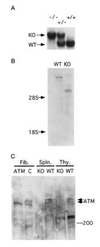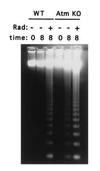Pleiotropic defects in ataxia-telangiectasia protein-deficient mice
- PMID: 8917548
- PMCID: PMC24050
- DOI: 10.1073/pnas.93.23.13084
Pleiotropic defects in ataxia-telangiectasia protein-deficient mice
Abstract
We have generated a mouse model for ataxia-telangiectasia by using gene targeting to generate mice that do not express the Atm protein. Atm-deficient mice are retarded in growth, do not produce mature sperm, and exhibit severe defects in T cell maturation while going on to develop thymomas. Atm-deficient fibroblasts grow poorly in culture and display a high level of double-stranded chromosome breaks. Atm-deficient thymocytes undergo spontaneous apoptosis in vitro significantly more than controls. Atm-deficient mice then exhibit many of the same symptoms found in ataxia-telangiectasia patients and in cells derived from them. Furthermore, we demonstrate that the Atm protein exists as two discrete molecular species, and that loss of one or of both of these can lead to the development of the disease.
Figures





References
-
- Sedgewick R, Boder E. In: Handbook of Clinical Neurology. Vinken P, Bruyn G, Klawans H, editors. New York: Elsevier; 1991. pp. 347–423.
-
- Swift M, Reitnauer P J, Morrell D, Chase C L. N Engl J Med. 1987;316:1289–1294. - PubMed
-
- Easton, D. F. (1994) Int. J. Radiat. Biol. 66, Suppl., S177–S182. - PubMed
-
- Metcalf J A, Parkhill J, Campbell L, Stacey M, Biggs P, Byrd P J, Taylor A M R. Nat Genet. 1996;13:350–353. - PubMed
-
- Pandita T K, Pathak S, Geard C R. Cytogenet Cell Genet. 1995;71:86–93. - PubMed
MeSH terms
Substances
LinkOut - more resources
Full Text Sources
Other Literature Sources
Medical
Molecular Biology Databases
Research Materials
Miscellaneous

